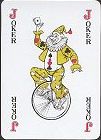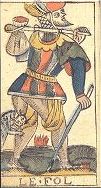The origin of this subject sinks deep into the history of western playing cards: in fact,
the concept of a "wild card" that can beat the high values of the deck was born with the
tarot.
 |  |
No Joker (or equivalent card) belonged to the earlier Arabic tradition, nor to
other archaic playing card systems known, such as Chinese Domino cards or Persian/Indian Ganjifa.
But an extra card featuring a traditional demon is found in many Japanese patterns, and even
in a Chinese one; although their function in play is not the same as a joker, their graphic
look is not too different from the western card. |
The ancestor of the modern Joker is the classic tarot's Fool.
Despite their close relationship, the latter card shows one main difference: belonging
to a set of 22 trumps, the Fool does not stand as an individual subject.
Nevertheless, in tarot games the Fool takes cards of high rank in the same way
modern Jokers do.
Graphically, the best proof of a relation between the two subjects is provided by the Fool's
direct "descendants" in regional tarot patterns: the Excuse in the French Tarot,
the Sküs in the German Tarock, the Skíz in the
Hungarian Tarokk, etc. are certainly more similar to Jokers than to the rest of the
trumps. |
 |  |
Therefore, with very few exceptions, Joker and Fool
cards alone are worth nothing, their paradox power emerging only in the case of a
challenge with another card.
 |
The choice of the Fool as a winning subject might appear strange, almost contradictory.
In the past, as well as in recent times, foolishness has never been looked at as
a virtue, and the rags worn by most tarot Fools confirm the low social status of this
personage.
Furthermore, according to the cultural models of the Renaissance, the age during
which the tarot game flourished in most European countries, this choice does not seem to match the
neo-Platonic model of man as the center of the universe, being the only living creature endowed
with thought. |
Renaissance, though, was not a hyper-rational age. Freed from the oppressive
embrace of the mediaeval church, man's progress was no longer guided by the light of pires
on which hereticals were burned, but was finally free to roam, and inspiration also came
from cultures which up to those times had been barely considered, or even proscribed. Among the
latter, for instance, was the Jewish tradition; in particular, the interest of several
Renaissance scholars was caught by its mystical-hesoteric doctrine, the Kabbalah. |
 |  |
 |
Also the original Italian name of the card, il Matto,
should be discussed: "Fool" is a slightly too liberal interpretation of this expression, for
which a closer translation would probably be "the Lunatic" or "the Madman".
In older times, when freedom of speech was yet to come, lunatics were always entitled
to express themselves freely, to say things that others could not, simply because their
crazy words would not be given credit, although sometimes they were true: their
insanity almost acted as a sort of intellectual shield or privilege. |
 |
 |
In most archaic cultures, an altered state of consciousness, or even sleep,
was believed to act as a psychic bridge between man and God. In the Bible, for instance,
several personages foresee future events or are given instructions by holy
messengers in their dreams. In the same way, psychic alteration was often
seen as a form of link with evil entities: the numberless cases of "possession" dealt with
by exorcists in the past, today would certainly receive a more rational
assessment. |
Also the ritual state of self-induced trance practised by tribal shamans and bush-doctors is a
typical example of this archetypal concept, once very common in the primitive world.
However, evident traces of this model may still be found in western hesoterism: for instance,
how could a medium makes us believe to be in contact with misterious entities without falling in a
trance? |

|
 |
Especially in the past, altered states of mind could have easily been burdened with
social and cultural implications that today would appear absurd.
For instance, in ancient Rome public assemblies were suspended in case one of the
participants was stricken by an epileptic crisis, since this sudden and unknown manifestation
was feared almost as a warning sign from heaven.
Therefore, it is likely that not the Fool's human condition did the unknown author of
the tarot game keep in mind by raising this subject to such a high rank, but his
allegedly privileged metaphysical status, for the same tarot game was probably created as a
symbolic representation of man's progress towards spiritual elevation (see the
Tarot gallery for a discussion of this topic). |
The modern Joker, instead, has an American origin, though once again
descending from Europe, in particular from Alsatia.
Officially, the Joker card was first used in the Unites States, during the second half of the
19th century, for playing the game of Euchre. This game was brought into the
American continent two centuries earlier, by German or Dutch settlers; in fact, the same word
"Euchre" is the English spelling of the old German term Juker, meaning "jack, knave", which later
became the name of the deck's new subject, i.e. the Joker. |
 |
 |
In this game, the most valuable cards are two Jacks (the one belonging to the trump
suit, and the other one of the same colour), known in play respectively as Right Bower
and Left Bower, a corruption of the German Bauer, "peasant" or "chess pawn",
a name also used for the knave in older card games. Some versions of Euchre use
a third Bower, called the Best Bower : the Joker was actually born to represent
the latter card, although some players still prefer to use another standard subject of the
deck, such as the 2 of Spades. |
 |  |
During the second half of the 19th century this extra card was given its present name
"Joker", and by the 1880s it began to appear in Bridge decks as a standard, sometimes with a
further extra blank card which could replace any of the subjects in the case they were damaged or lost.
Only during the first half of the 20th century the Joker cards became two (usually one red
and one black, to match the Bowers' colour, but sometimes one with colours and one in
black & white). Some decks now have three, or even more. |
And a jester is indeed an ideal personage for the crowded court of
playing cards, which includes four kings, four queens and four knaves
or jacks.
Besides some exterior similarities (both the Fool and the Joker wear patched clothes,
feature funny faces and show informal attitudes), there is something
more important that relates these two subjects.
If mental insanity once granted lunatics freedom of speech, and was even believed to bridge
the gap between common mortals and heaven, in most Renaissance households the jester, often
a hunchback or a dwarf, though being the least member of the court as for social rank, was
also the only subject officially entitled to play with the king (or prince, or duke), to
tease him, to tell him things which others could barely do without the risk of enduring
serious consequences. The same glamorous clothes worn by the jester made him clearly
identifiable among all other members of the court: a personage who, at the same time, was
ridiculous yet outstanding, deformed yet witty. |
 |
back to